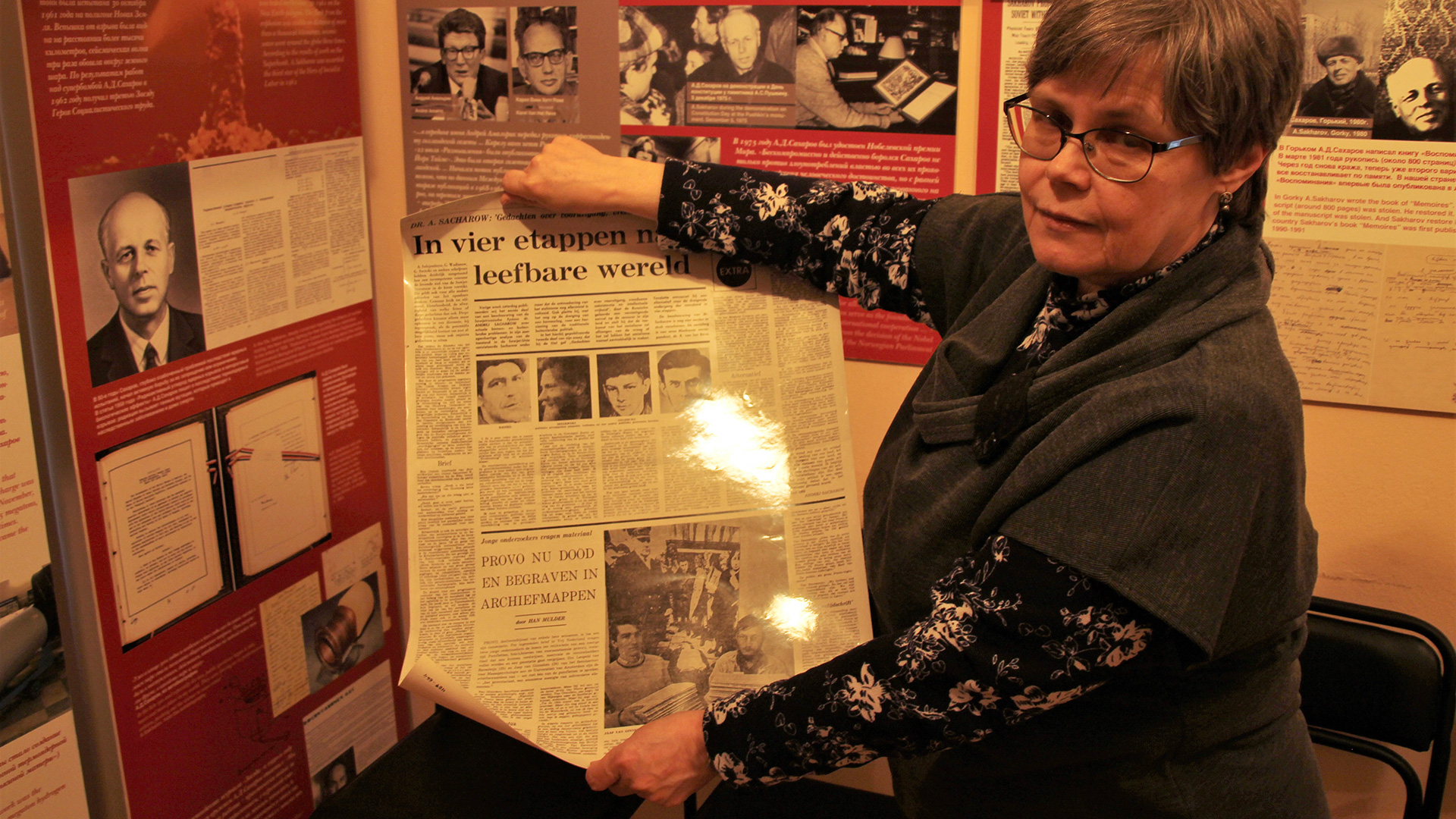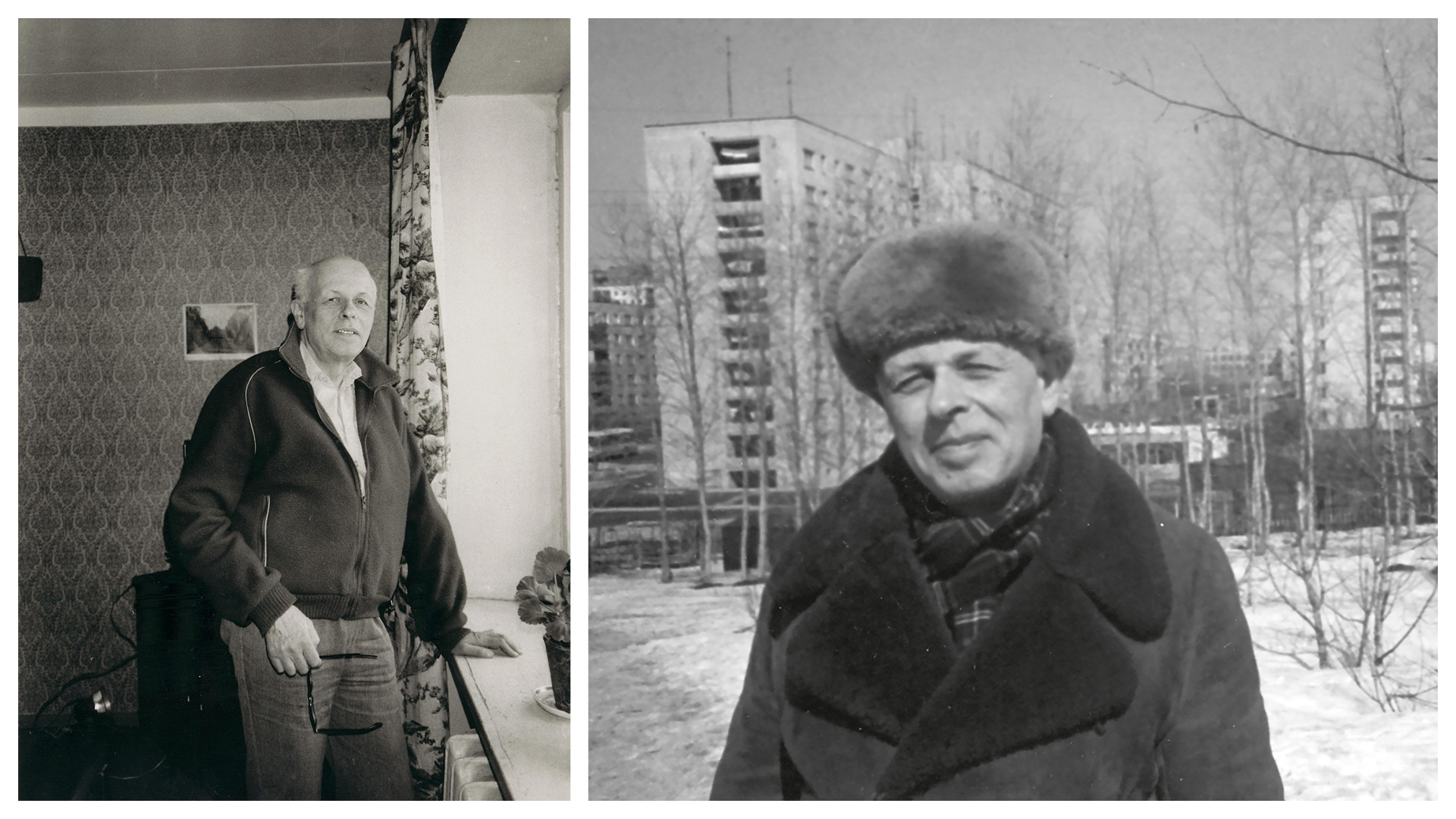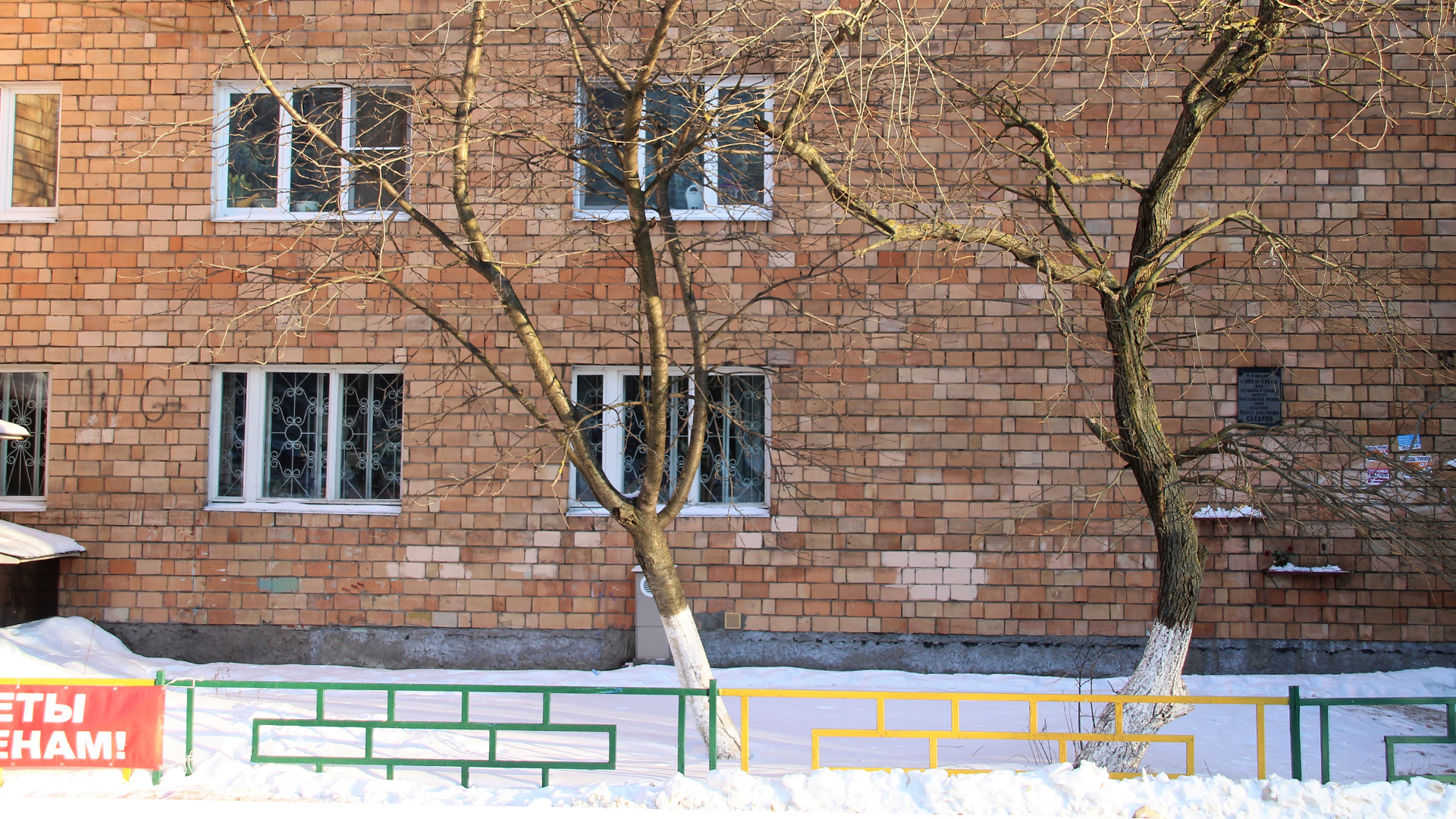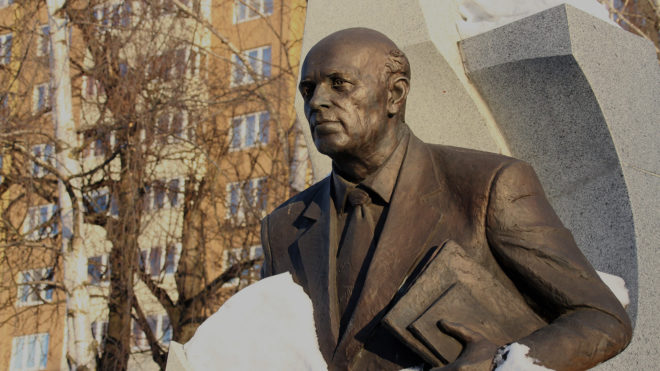Nizhny Novgorod 2018
NO TOUCHSCREENS OR TABLETS
‘His article is still relevant,’ Lyubov Potapova says. She walks away and comes back with a plasticised page of Het Parool (an Amsterdam-based newspaper) of 13 July 1968. She unrolls the page on a table in the Sakharov Museum in Nizhny Novgorod, four hundred kilometres east of Moscow.The headline 'In four stages towards a liveable world' immediately catches the eye. It is the second and final part of the famous essay by Andrei Sakharov, the father of the Soviet hydrogen bomb.
It is ten days after Russian President Vladimir Putin’s speech of early March in which he bragged about new supersonic nuclear weapons, when director Potapova gives a tour of the Sakharov Museum in Nizhny Novgorod. It is located in the four-room apartment to which Sakharov was banned in 1980 because of his persistent criticism of the Soviet regime.
Potapova, guiding me through the hallway with at the end a portrait of Sakharov, points at his old living room and bedroom on the right side, with brown furniture, orange upholstery and a cabinet with family photos arranged just like back in the day. She stops in the exhibition space that shows Sakharov’s life story, told through newspaper articles, documents, photographs and anecdotes from Sakharov's autobiography. This is not a museum of touchscreens and tablets.
When reading his essayThoughts on progress, peaceful coexistence and intellectual freedom, one cannot but be struck by the similarities with the world today. The nuclear scientist pointed out the danger of atomic weapons fifty years ago. He detested ‘spheres of influence’ and military aggression, and he criticised nationalism, extremism, dictatorships, dogmatism, and racism. Sakharov argued for intellectual freedom and not only fiercely criticised the lack of democracy in the Soviet Union but for example racism in the United States as well. And, not unimportantly, he offered solutions to solve those problems in four steps, among others by allowing socialism and capitalism to grow towards each other, as an alternative to the complete destruction of humanity.
In the office part of the museum, Potapova puts biscuits, chocolate and tea on the table. Thoughtfully and carefully choosing her words, in the spirit of the former occupant, she takes the time to speak about the life and ideas of the man with whom she never talked, but who has profoundly influenced her life.
The Object 1968
Two rows of barbed wire
In 1968 Andrej Sakharov worked in The Object, a remote nuclear research centre between fields and forests. The site was surrounded by two rows of barbed wire. On 10 July, Sakharov was listening to the radio, a some time after his essay had been published. He would later write about this in his autobiography:
‘On the 10th of July […] I was listening to the BBC’s evening broadcast (or the Voice of America, I don’t remember) and then I heard my name. They said that on 6 July a Dutch newspaper had printed an article from A.D. Sakharov, a member of the Academy of Sciences of the USSR [...].’
Sakharov had written his essay because he understood that the time had come that he, as an intellectual, had to speak openly about the great questions of his time. As the father of the Soviet hydrogen bomb, he felt personally responsible. Through his work, Sakharov knew the totalitarian Soviet system well and understood the dangers of a regime that can act without opposition. Earlier that year, he had heard about the Prague Spring. He had felt the excitement, the hope and the enthusiasm about ‘socialism with a human face’. That same year, something remarkable happened in the Soviet Union as well. Sakharov called it a kind of ‘mini-version’ of the Prague Spring. After three dissidents had been convicted, a thousand signatures were collected in their defence. This was unprecedented under a suffocating regime.
Sakharov’s essay came as a shock to the Kremlin. Moscow did not appreciate these dangerous ideas from a respected Soviet scientist who saw similarities between Stalin, who had won the Second World War, and Hitler. A scientist, moreover, who did not reject capitalism, Moscow’s ideological enemy. Two deadly sins. The authorities prevented the publication of the essay. It ended up in the samizdat (the underground literary circuit) and circulated within a small group. The essay went unnoticed by a wider audience.
But the article did find its way abroad and ended up with the Dutch writer Karel van het Reve, who was a correspondent in Moscow at the time. Sakharov wrote: ‘[…] I did not know that a few people had already tried to get the manuscript abroad through a correspondent of the American New York Times, but he refused the manuscript because he was afraid it was a forgery or a provocation. After that, Andrej Amalrik (a dissident and writer, FA) gave it in mid-June to Karel van het Reve, the correspondent of a Dutch newspaper, I believe the Amsterdams Avondblad (it was Het Parool, an Amsterdam-based newspaper, FA).’
Without knowing him personally, Van het Reve made Sakharov world-famous. People outside the Soviet Union suddenly heard a different point of view from inside the closed-off Soviet bloc. And not just from anyone, but from the father of the Soviet hydrogen bomb, who had always been treated with respect in the Soviet Union. After Het Parool, The New York Times followed with a publication, and it was picked up by the rest of the world. ‘I remember that, according to the International Publishers Association, the total circulation of my piece in the years 1968-1969 was eighteen million; that made me end up in third place, after Mao Zedong and Lenin but before Georges Simenon and Agatha Christie,’ Sakharov wrote proudly.
Gorky 1980
An agent guards the front door
‘The article completely changed Sakharov’s life,’ Potapova remembers. No longer ‘just’ a scientist, he became the humanitarian, enlightened conscience of the country. It gave the people who did not agree with the rulers in the Soviet Union a voice. In 1975 Sakharov received the Nobel Peace Prize. However, he was not allowed to leave the country to collect it.
In 1979 Sakharov expressed his criticism of the Soviet invasion of Afghanistan to the foreign media. Again, his statements enraged the Soviet leaders, and the Kremlin put him and his wife in January 1980 on a plane for a one-way trip to Gorky, his place of exile. He ended up in a four-room apartment in a suburb of the city. Gorky (named after the Russian writer Maxim Gorky and known since 1990 as Nizhny Novgorod) was forbidden for foreigners because of the presence of military industry. The Kremlin did not want prying eyes, so no journalist could visit Sakharov. He did not get a phone. An agent guarded the front door and the KGB, the secret service, kept watch outside. Whenever Sakharov left his apartment, he was shadowed by KGB agents. When he drove his car, he was followed, often even by two cars, aiming to intimidate him. ‘Sometimes they tried to scare us by creating a situation that could lead to an accident,’ Sakharov later wrote in his autobiography.
Sakharov’s new flat was located in an apartment building in which the teenager Lyubov Potapova also lived. In the days prior to Sakharov's arrival, police cars appeared at the building, she says. The residents suspected that something special was about to happen. Once he had arrived, they realised who was coming to live in the apartment on the ground floor. ‘We knew his face. Andrei Dmitrievich Sakharov was, of course, a well-known physicist. But we didn’t know why he moved into our building.’
‘Others who listened to foreign radio stations told me why Sakharov was staying in Gorky,’ the director of the Sakharov Museum continues. ‘But I wasn’t interested in him. I was eighteen years old. I was in my first year of college and trying to make new friends.’ She would occasionally run into him at the entrance of the apartment building, but they never exchanged words. ‘He understood that he should not talk to us because that would put us in danger. We saw that it was better for us not to say anything to him either. We didn’t know anything about his ideas. There wasn’t a lot of talk about it. With some other students, we asked our lecturer in political economics why Sakharov was in exile. He said: “I don’t know, and I advise you not to know either.”’
Gorky 1986
‘Good afternoon, this is Gorbachev speaking’
In the evening of 15 December 1986, Sakharov’s doorbell rang. Two mechanics, accompanied by a KGB-agent, began to install a white phone. ‘Tomorrow around ten you will be called,’ the KGB-agent said when he left. The next day at three o’clock, just when Sakharov was about to get bread, the phone rang.
‘Good afternoon, this is Gorbachev speaking.’
‘Good afternoon,’ Sakharov replied.
‘You will have the opportunity to come back to Moscow’, Gorbachev announced. ‘The decree of the Presidium of the Supreme Soviet will be revoked.’
Two days later, Sakharov and his wife took a train to the capital. Their release was coherent with the more open Soviet Union of new leader Mikhail Gorbachev. In Moscow, Sakharov was committed to reducing the number of missiles in Europe. He argued for the reduction of the Soviet army and pointed out the dangers of nuclear energy. In March 1989 he was elected to the new parliament but later that same year, on 14 December, he passed away. The people massively paid him their last respects. Two years later, the Sakharov Museum opened in his former flat in Nizhny Novgorod.
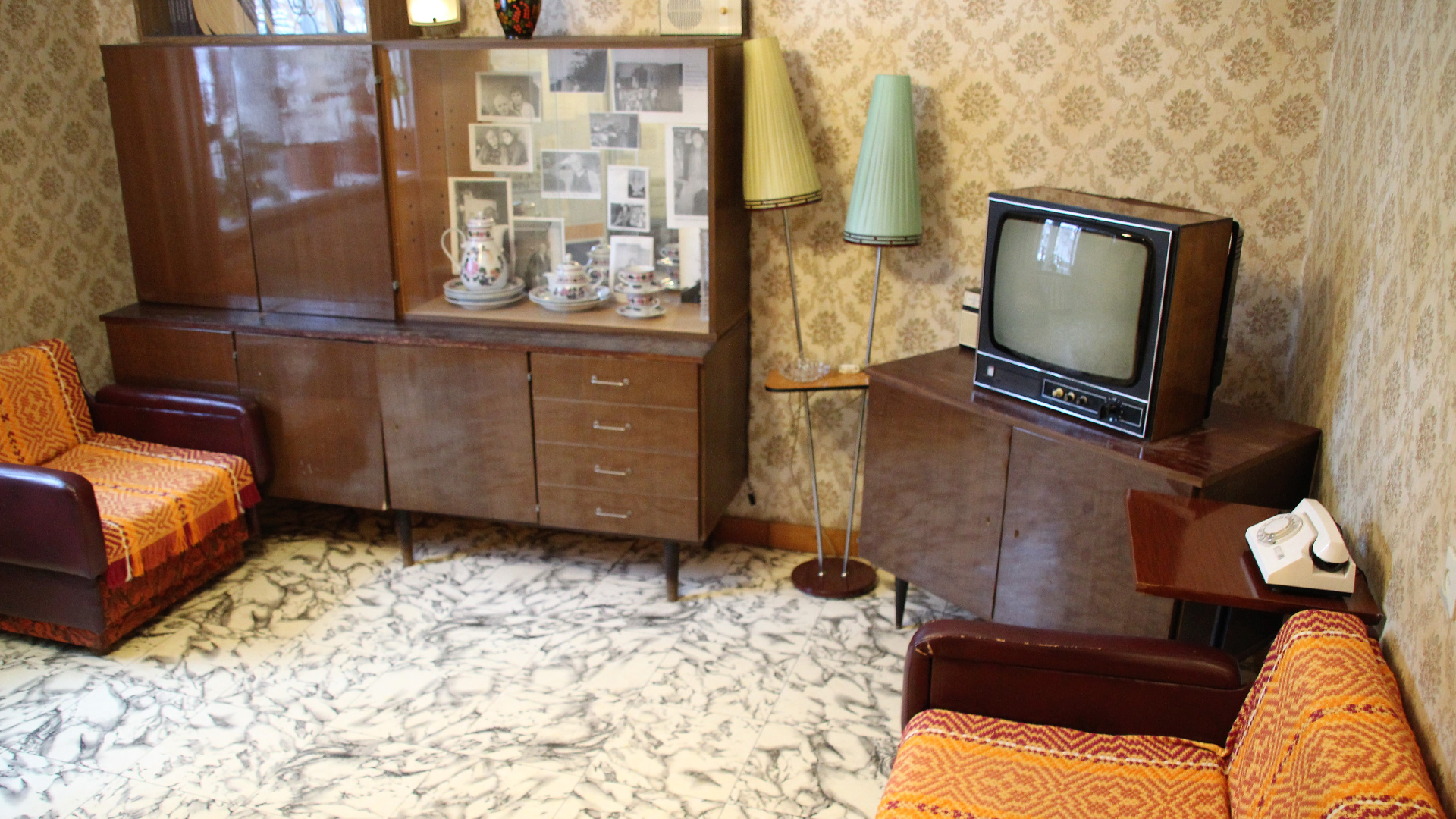
Nizhny Novgorod 2018
‘What is more important?’
‘The years after the fall of the Soviet Union in 1991 were a difficult time,’ the director of the museum remembers. ‘I taught math at a school, but I didn’t get paid.’ In 1991 Nizhny Novgorod was no longer closed to foreigners. ‘Russia opened up. Things were written about many new subjects. All sorts of books and magazines became available. I learned more and more about Sakharov’s history. Then in 1993, I saw a vacancy for a cashier in the museum and they hired me. There I worked as a guide, a research assistant, the head curator and in 2000 I became the director. In the early years, there were many visitors. Even his former guards came to see how Sakharov had lived.’
Now buses no longer travel regularly to and from the Sakharov Museum. Only two thousand visitors per year are left. In school, they no longer teach children about him. The memory of Sakharov is getting weaker. ‘Russians over forty years, who grew up in the Soviet Union, admire his work as a scientist but think he is a bad politician,’ Potapova explains. ‘But in the context of the present-day relationship between Russia and the West, his essay is still relevant. Although there are some differences between then and now,’ she stresses. 'Current world leaders can learn from Sakharov’s solutions,’ Potapova thinks,‘because he rose above national interests and stood up for the interests of people. ‘For what is more important? Humankind or your own country?’ she asks rhetorically. ‘This question is more relevant than ever. Unfortunately, politicians do not think in the spirit of Sakharov.’
Fifty years ago, the nuclear scientist emphasised the importance of a military equilibrium. No country should be superior to another. The temptation would be too great to carry out an attack. And in his relation to the West, it is precisely this point about which Putin regularly expresses his frustration. Sakharov also attached great importance to intellectual freedom, which enables the people to control and judge those in power, and which also provides fresh and new ideas.
‘You have to be free to think without pressure,’ Potapova stresses. ‘When people talk about problems openly, it will lead to solutions. Then you do not have to take up arms. There is more individual freedom in Russia now than during the Soviet Union era, but there is no complete freedom. Just look at the murder of Boris Nemtsov (the politician and Putin critic murdered in 2015, who was governor of the Nizhniy Novgorod region in the nineties, FA).’ She continues morosely: ‘It is still not clear who gave the order. The highest politicians should involve themselves in the investigation and not remain silent. Sakharov would not have been happy with this.’
Potapova does not see a new Sakharov. ‘Nobody has a brain like his. He understood problems immediately, where we need ten steps. In Russia, there is no one with such vision. No world leader has that. But we need one.’
In the museum, financed by local authorities, everything is focused on preserving and disseminating Sakharov’s legacy and ideas. The museum’s crowning glory is the white telephone in the living room, the original one that Sakharov released from his exile. Potapova feels a connection to the nuclear scientist. ‘Of course, it would have been fascinating to talk to Sakharov back then. But that was impossible. The monitoring system, the guard at the entrance who let no one go inside...It was clear that you could not have a conversation with him. You might be disappointed that you did not do anything when you could have done something. But in this situation, I could not have spoken to Sakharov, so I can’t regret it.’
This article is based on an interview with Lyubov Potapova and conversations with Marina Sjajchoetdinova, chief curator of the Sakharov Museum in Nizhny Novgorod, and Sergej Loekasjevski, director of the Sakharov Centre in Moscow.In addition, there were conversations with Dmitri Soeslov, associate professor at the Department of Economics and International Relations at the Higher School of Economics in Moscow and program director of Valdai, a discussion club and think tank. Andrei Sakharov’s autobiography My Lifehas been usedas well.
